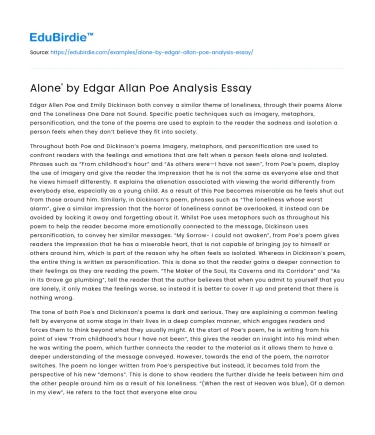Edgar Allen Poe and Emily Dickinson both convey a similar theme of loneliness, through their poems Alone and The Loneliness One Dare not Sound. Specific poetic techniques such as imagery, metaphors, personification, and the tone of the poems are used to explain to the reader the sadness and isolation a person feels when they don’t believe they fit into society.
Throughout both Poe and Dickinson’s poems imagery, metaphors, and personification are used to confront readers with the feelings and emotions that are felt when a person feels alone and isolated. Phrases such as “From childhood’s hour” and “As others were—I have not seen”, from Poe’s poem, display the use of imagery and give the reader the impression that he is not the same as everyone else and that he views himself differently. It explains the alienation associated with viewing the world differently from everybody else, especially as a young child. As a result of this Poe becomes miserable as he feels shut out from those around him. Similarly, in Dickinson’s poem, phrases such as “The loneliness whose worst alarm”, give a similar impression that the horror of loneliness cannot be overlooked, it instead can be avoided by locking it away and forgetting about it. Whilst Poe uses metaphors such as throughout his poem to help the reader become more emotionally connected to the message, Dickinson uses personification, to convey her similar messages. “My Sorrow- I could not awaken”, from Poe’s poem gives readers the impression that he has a miserable heart, that is not capable of bringing joy to himself or others around him, which is part of the reason why he often feels so isolated. Whereas in Dickinson’s poem, the entire thing is written as personification. This is done so that the reader gains a deeper connection to their feelings as they are reading the poem. “The Maker of the Soul, Its Caverns and its Corridors” and “As in its Grave go plumbing”, tell the reader that the author believes that when you admit to yourself that you are lonely, it only makes the feelings worse, so instead it is better to cover it up and pretend that there is nothing wrong.
Save your time!
We can take care of your essay
- Proper editing and formatting
- Free revision, title page, and bibliography
- Flexible prices and money-back guarantee
The tone of both Poe's and Dickinson’s poems is dark and serious. They are explaining a common feeling felt by everyone at some stage in their lives in a deep complex manner, which engages readers and forces them to think beyond what they usually might. At the start of Poe’s poem, he is writing from his point of view “From childhood’s hour I have not been”, this gives the reader an insight into his mind when he was writing the poem, which further connects the reader to the material as it allows them to have a deeper understanding of the message conveyed. However, towards the end of the poem, the narrator switches. The poem no longer written from Poe’s perspective but instead, it becomes told from the perspective of his new “demons”. This is done to show readers the further divide he feels between him and the other people around him as a result of his loneliness. “(When the rest of Heaven was blue), Of a demon in my view”, He refers to the fact that everyone else around him is described as heaven and blue, meaning that they are joyful and hopeful, whereas he has a demon in his view that is blocking him from feeling positive emotions. Dickinson’s poem on the other hand is written from “The Maker of the Soul’s” perspective. Having this narrator tell the poem connects the reader on a deeper level as everyone is the maker of their souls, meaning that theoretically, we as readers are the ones narrating the poem. This perspective allows the reader to explore a deep kind of loneliness, that is felt even when one does not want to admit it to themselves. “I fear me this—is Loneliness—“, towards the end of the poem the weakness the narrator feels as they are fighting their feelings is portrayed through the sad tone the poem has, “And Being under Lock—“, you can tell that the narrator feels trapped in their emotions and this is a feeling that is made to be conveyed to readers.
In conclusion, Edgar Allen Poe and Emily Dickinson both convey the similar theme of loneliness, through their poems Alone and The Loneliness One dare not sound, by the use of techniques such as imagery, metaphors, personification, and the tone of the poems.






 Stuck on your essay?
Stuck on your essay?

